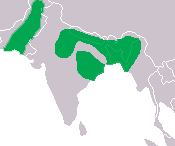Gavial: Perbedaan antara revisi
Tampilan
Konten dihapus Konten ditambahkan
kTidak ada ringkasan suntingan |
Tidak ada ringkasan suntingan |
||
| Baris 19: | Baris 19: | ||
}} |
}} |
||
'''Gavial''' atau '''gharial''' (''Gavialis gangeticus'') adalah bangsa [[crocodilian]] dari [[familia|family]] '''[[Gavialidae]]''' yang berasal dari [[anak benua |
'''Gavial''' atau '''gharial''' (''Gavialis gangeticus'') adalah bangsa [[crocodilian]] dari [[familia|family]] '''[[Gavialidae]]''' yang berasal dari [[anak benua India]]. Saat ini hewan ini dimasukkan dalam kategori [[critically endangered species|''Bahaya Kritis'']] oleh [[IUCN]].<ref name="iucn">{{IUCN |assessors=Choudhury, B. C., Singh, L. A. K., Rao, R. J., Basu, D., Sharma, R. K., Hussain, S. A., Andrews, H. V., Whitaker, N., Whitaker, R., Lenin, J., Maskey, T., Cadi, A., Rashid, S. M. A., Choudhury, A. A., Dahal, B., Win Ko Ko, U., Thorbjarnarson, J., Ross, J. P. |year=2007 |id=8966 |taxon=Gavialis gangeticus |version=2012.2}}</ref> |
||
The gharial is one of three crocodilians native to [[India]], apart from the [[mugger crocodile]] and the [[saltwater crocodile]].<ref name=Choudhury2006>Choudhury, B.C. (ed.) (2006). [http://www.wmi.com.au/csg18/documents/2.7_West_Asia_Regional.pdf ''West Asia Regional Report'']. Crocodile Specialist Group Steering Committee Meeting, 19 June 2006.</ref> It is one of the longest of all living crocodilians.<ref name=whitaker1983>{{cite journal|author=Whitaker, R. and D. Basu |year=1983|title=The Gharial (''Gavialis gangeticus''): A review |journal=Journal of the Bombay Natural History Society |volume=79|pages= 531–548}}</ref> |
The gharial is one of three crocodilians native to [[India]], apart from the [[mugger crocodile]] and the [[saltwater crocodile]].<ref name=Choudhury2006>Choudhury, B.C. (ed.) (2006). [http://www.wmi.com.au/csg18/documents/2.7_West_Asia_Regional.pdf ''West Asia Regional Report'']. Crocodile Specialist Group Steering Committee Meeting, 19 June 2006.</ref> It is one of the longest of all living crocodilians.<ref name=whitaker1983>{{cite journal|author=Whitaker, R. and D. Basu |year=1983|title=The Gharial (''Gavialis gangeticus''): A review |journal=Journal of the Bombay Natural History Society |volume=79|pages= 531–548}}</ref> |
||
Revisi per 10 Mei 2013 05.35
| Gharial | |
|---|---|

| |
| Klasifikasi ilmiah | |
| Kerajaan: | |
| Filum: | |
| Kelas: | |
| Ordo: | |
| Famili: | |
| Genus: | |
| Spesies: | G. gangeticus
|
| Nama binomial | |
| Gavialis gangeticus (Gmelin, 1789)
| |

| |
Gavial atau gharial (Gavialis gangeticus) adalah bangsa crocodilian dari family Gavialidae yang berasal dari anak benua India. Saat ini hewan ini dimasukkan dalam kategori Bahaya Kritis oleh IUCN.[1]
The gharial is one of three crocodilians native to India, apart from the mugger crocodile and the saltwater crocodile.[2] It is one of the longest of all living crocodilians.[3]
The Nepali and Hindi word घड़ा ghaṛā means earthenware pot, pitcher, water vessel.[4][5] -->
Referensi
- ^ a b Choudhury, B. C., Singh, L. A. K., Rao, R. J., Basu, D., Sharma, R. K., Hussain, S. A., Andrews, H. V., Whitaker, N., Whitaker, R., Lenin, J., Maskey, T., Cadi, A., Rashid, S. M. A., Choudhury, A. A., Dahal, B., Win Ko Ko, U., Thorbjarnarson, J., Ross, J. P. (2007). "Gavialis gangeticus". IUCN Red List of Threatened Species. Version 2012.2. International Union for Conservation of Nature.
- ^ Choudhury, B.C. (ed.) (2006). West Asia Regional Report. Crocodile Specialist Group Steering Committee Meeting, 19 June 2006.
- ^ Whitaker, R. and D. Basu (1983). "The Gharial (Gavialis gangeticus): A review". Journal of the Bombay Natural History Society. 79: 531–548.
- ^ Turner, R. L. (1931). "A Comparative and Etymological Dictionary of the Nepali Language".
- ^ Bahri, H. (1989). Learners' Hindi-English dictionary. Siksarthi Hindi-Angrejhi sabdakosa. Rajapala, Delhi.

